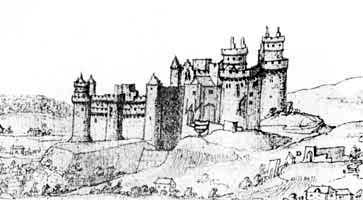
Picardie


Aisne |
Oise |
Other regions & other castles |
Previous months’ selections |
|
Castle of Pierrefonds |
|
|
- The history The castle of Pierrefonds is located at a hundred kilometers in the north of Paris, between Compiegne and Soissons, in the old province of Valois. This one had been attached to the royal field under Philippe-Auguste in 1181, and the châtellenie of "Pierrefonts", position of refuge and strategic monitoring in skirt of forest of Compiegne, was repurchased with having the right. 1371. Charles V gives the county of Valois to his second Louis wire of Orleans as of his birth. This donation is confirmed in 1386, at the moment of its marriage with Valentine Visconti (girl of the duke of Milan). From 1392. The king Charles VI is taken crises of insanity which will not cease any more until its death. The authority in the kingdom becomes dubious and a bloody competition develops between two parties claiming to control in the name of the king: the Burgundian ones combined to the English (with claims on the throne of France) and the Armagnacs, combined to Louis of Orleans. This last, being claimed frustrated its rights of regent of the kingdom, makes build or repair several castles to constitute a vast military network suitable to dominate the north of Paris and whose Pierrefonds could constitute an ultimate tiny room.
1407. Louis of Orleans is assassinated in Paris by the partisans of the Burgundian ones. 1415. The king of England Henri V, benefitting from the disorders and strong of his alliance with the Burgundian ones, gains the victory of Azincourt against the Armagnacs. Charles of Orleans, heir to Pierrefonds, is made prisoner. There will remain 25 years prisoner in England and he will express in his worms the nostalgia of "his douice France": ' By looking towards the country of France One day occurred me, in Dover on the sea That it remembered the soft pleasure That I soûlais * to that the country to find; And began heart certainly to sigh Combien that large good me faisoit to see France which my heart to like owes. 1420. The treaty of Troyes, with the support of the queen of Isabeau France of Bavaria, disinherits the dolphin (future Charles VII), recognizes Henri V of England like heir to the kingdom and regency confers to him. 1422. Henri V, then Charles VI die in two months of interval. this situation creates one period of uncertainty which will dissipate Jeanne d' Arc while making recognize the legitimacy of Charles VII in 1429. Charles of Orleans is released in 1440. A truce with the English intervenes in 1444 and puts an end to the One hundred year old war. |
|
Castle of the month : |
Search |
For any question concerning this Web site, send a message to webmaster


 1397.
The building work of the castle progresses quickly and will be completed
less than ten years later, since one 1406, all the court moves to
assist with the marriage of the future Charles poet of Orleans,
wire elder of Louis.
1397.
The building work of the castle progresses quickly and will be completed
less than ten years later, since one 1406, all the court moves to
assist with the marriage of the future Charles poet of Orleans,
wire elder of Louis.
